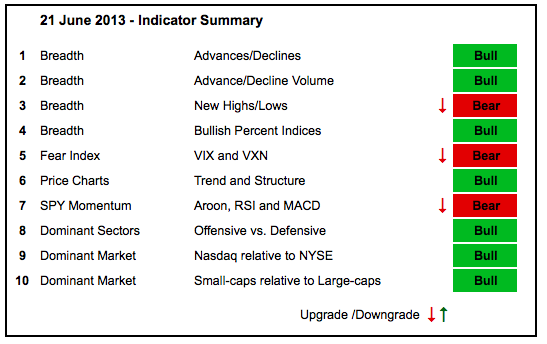With weakness throughout June, three indicators were downgraded to bearish in the indicator summary. It is a rather strange trio though. Net New Highs are considered bearish because NYSE Net New Highs plunged to their lowest reading in over a year. The VIX surged above 20% to show the most fear in months. Momentum, unsurprisingly, turned bearish as all three indicators crossed their bearish thresholds. Relative weakness in the three defensive sectors is perhaps the strangest thing about the June decline, which leads me to believe it is a correction within a bigger uptrend.


- AD Lines: Bullish. The NYSE and Nasdaq AD Lines peaked in May and have fallen the last 4-6 weeks. The long-term trends remain up and the 125-day EMAs of Net Advances remain positive.
- AD Volume Lines: Bullish. Weakness in the Nasdaq and NYSE AD Volume Lines has been less pronounced over the last 4-6 weeks. The Nasdaq AD Volume Line has been flat, while the NYSE AD Volume Line edged lower and remains well above its April low.
- Net New Highs: Bearish. NYSE Net New Highs plunged to their lowest level in over a year and the cumulative line broke the 10-day EMA. Nasdaq Net New Highs turned negative this week, but the cumulative line remains above its 10-day EMA.
- Bullish Percent Indices: Bullish. All nine BPIs are above 50%. The Materials BPI ($BPMATE) is the weakest at 60%.
- VIX/VXN: Bearish. The S&P 500 Volatility Index ($VIX) and the Nasdaq 100 Volatility Index ($VXN) surged above 20% and broke their February-April highs.
- Trend-Structure: Bullish. It is hard to use the early June lows as key support for a long-term uptrend. Even though the major index ETFs broke these lows, the April lows are much more important to the long-term uptrend.
- SPY Momentum: Bearish. Although just barely, RSI broke below 40 (39.96) and MACD(5,35,5) broke into negative territory (-.311). The Aroon Oscillator broke below -50 to turn bearish.
- Offensive Sector Performance: Bullish. The Consumer Staples SPDR (XLP), Utilities SPDR (XLU) and Healthcare SPDR (XLV) are leading the way lower, which means the offensive sectors are holding up better and showing relative strength (XLF, XLI, XLK, XLY).
- Nasdaq Performance: Bullish. The $COMPQ:$NYC ratio moved to a new high for the year because the NY Composite ($NYA) is underperforming the Nasdaq, which means the Nasdaq is outperforming.
- Small-cap Performance: Bullish. The $RUT:$OEX ratio is still in an uptrend since early May as small-caps outperform large-caps.
- Breadth charts (here) and intermarket charts (here) have been updated.
This commentary and charts-of-interest are designed to stimulate thinking. This analysis is
not a recommendation to buy, sell, hold or sell short any security (stock ETF or otherwise).
We all need to think for ourselves when it comes to trading our own accounts. First, it is
the only way to really learn. Second, we are the only ones responsible for our decisions.
Think of these charts as food for further analysis. Before making a trade, it is important
to have a plan. Plan the trade and trade the plan. Among other things, this includes setting
a trigger level, a target area and a stop-loss level. It is also important to plan for three
possible price movements: advance, decline or sideways. Have a plan for all three scenarios
BEFORE making the trade. Consider possible holding times. And finally, look at overall market
conditions and sector/industry performance.

About the author:
Arthur Hill, CMT, is the Chief Technical Strategist at TrendInvestorPro.com. Focusing predominantly on US equities and ETFs, his systematic approach of identifying trend, finding signals within the trend, and setting key price levels has made him an esteemed market technician. Arthur has written articles for numerous financial publications including Barrons and Stocks & Commodities Magazine. In addition to his Chartered Market Technician (CMT) designation, he holds an MBA from the Cass Business School at City University in London.
Learn More